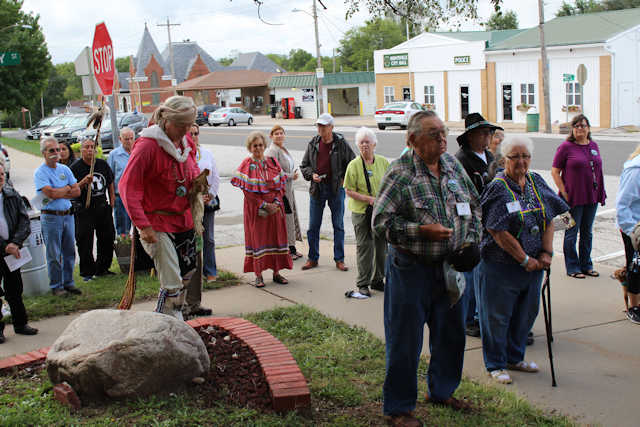 Huntsville, Missouri, Trail of Death marker at the courthouse. George Godfrey blesses the marker with tobacco, sweet grass, cedar and sage, while the Potawatomi and guests turned with him to face the four sacred directions. (Click image for a larger view.)
Huntsville, Missouri, Trail of Death marker at the courthouse. George Godfrey blesses the marker with tobacco, sweet grass, cedar and sage, while the Potawatomi and guests turned with him to face the four sacred directions. (Click image for a larger view.)
On Thursday Sep 20, 2018, we crossed the mighty Mississippi River to West Quincy, Missouri. A Trail of Death marker at the second Ayerco gas station was our first stop.
We had breakfast with the Heritage Seekers at Hardee’s restaurant in Palmyra. They escorted us to Big Spring Park so we could taste the water. Legend tells that if you drink this water, you will return some day.
Then we traveled gravel roads to the historic Gander house south of Monroe City. Josephine and Clifford Gander had hosted our caravan there several times but are deceased now. Their daughter, Alice Gander Bell, and granddaughter had prepared a big spread for our lunch. This was the high light of the whole trip. We sat on the porch overlooking the former road and across the meadow where deer and eagles could be seen. The Potawatomi walked on that former road in 1838. We hated to leave and travel on.
We drove by the United Methodist Church where Jo and Cliff Gander had erected a Trail of Death marker. A picture of them is on our Facebook page and website.
The next stop was Paris which has a museum inside the courthouse. Refreshments were served and we had the chance to meet the local folks. A black priest from Nigeria prayed for our safe journey. This is a beautiful courthouse with murals depicting history of the county.
At Moberly we visited the Trail of Death marker in Rothwell Park. It was a long walk so transportation in golf carts was provided.
We ate supper in Felicia Restaurant, hosted y Randolph County Historical Society, Joyce A. Cooper-Campbell and Joe Barnes.
Friday Sep 21 found us in Moberly, Missouri. We visited the Huntsville museum and saw the Trail of Death marker at the courthouse.
We drove by the Salisbury Trail of Death marker at the Scout Cabin. In Keytesville we drove by the Trail of Death marker near the Confederate General Sterling Price statue. You may recall that in the movie “True Grit” John Wayne’s cat was named General Sterling Price.
At Brunswick boat ramp we met Don and Mary Riddle. This is where Cub Scouts erected a Trail of Death marker in 1999. They accompanied us to eat lunch at DeWitt community center, which had a big turn- out but no school kids this year.
The museum was not open at Carrollton. This is a large museum and I fear they are having financial difficulties because the museum is open only on Saturdays now.
Richmond High School had prepared a ceremony to meet us and many students came out to learn what the Trail of Death was all about. The rock on which two plaques were attached is deteriorating so local people said they would find a better boulder to put it on. One of the plaques is a map of the Trail of Death. One plaque was made by a student/ Boy Scout and one was by the Ray County Historical Society.
After crossing the Missouri River on a new bridge, we drove by the Trail of Death marker and Madonna of the Trail at Lexington. We also drove by the Wellington and Napoleon markers. Apparently these little towns were named for Napoleon’s defeat in 1815.
Near Bucker we went back the lane to Fire Prairie Creek Wetland Park. Gene Pittman, Scout leader, and Boy Scouts met us there with bottles of water.
Next was Lake City Bicycle Park where we walked over a bridge and on a path to the Trail of Death marker.
We visited the historical marker and log cabin at Pioneer Spring Park in Independence, Missouri. Roy and Julia Slavin, Citizen Potawatomi regional representatives, met us. Julia told how the Trail of Death marker was broken by a city mower and she got the city to replace it. Now it has blocks around it to keep the mower away.
We bought fast food and took it to the National Frontier Trails Museum to eat together. We stayed in hotels at Independence, MO.
Linda Anderson, Citizen Potawatomi, wrote: “It was extremely dusty on gravel roads. When I turned on the windshield wipers, clumps of dirt fell away. I imagined the Potawatomi in 1838 walking behind wagons that stirred up the dust. Being covered in it, the dust filling their eyes and mouths, sticking to their sweat. I can’t even imagine how horrible that would have been. We had showers and comfortable rooms and plentiful food at the end of each day. They didn’t.”
|